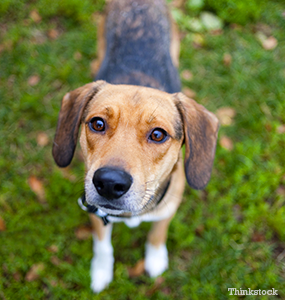Background
No positive origin has ever been established for the Harrier. According to one theory the earliest Harriers were bred down in size from the English Foxhound. According to another, they were a cross between the former Southern Hound and the Greyhound.
The first recorded Harrier pack in England dates to 1260 and was organized by Sir Elias de Midhope. While Harriers are best known for their hare hunting skill they’re also adept at hunting fox, rabbits and even stag.
The Harrier was recognized in 1885 by the American Kennel Club.
Sizing up
- Weight: 40 to 60 lbs.
- Height: 18 to 22 inches
- Coat: Short, dense
- Color: Any combination of black, white, tan, red, and lemon
- Life expectancy: 12 to 15 years
What’s the Harrier like?
The Harrier is often mistaken for a smaller English Foxhound or a taller Beagle.
As a member of the hound breed, he is very outgoing and loves people and also other dogs. Because of his pack dog ancestry, being alone is not something he is fond of, and he’s likely to suffer from separation anxiety. The Harrier is a very vocal dog and loves to have conversations.
The Harrier is very sweet-tempered and great with children. He loves to run and explore, and with his hunting roots he could catch a whiff of something and be off in seconds so be sure to keep an eye on him or consider a fenced yard.
The Harrier’s coat is relatively easy to groom with a weekly brushing.
Health
The Harrier is generally a healthy dog but watch for hip dysplasia.
Takeaway Points
- The Harrier is a very rare breed so you should be prepared to join a waiting list if you would like one.
- The Harrier is very energetic and can be an excellent running partner!
- The Harrier is suitable for a family that can give him the attention he needs but he doesn’t like to be alone.
If you have any questions or concerns, you should always visit or call your veterinarian -- they are your best resource to ensure the health and well-being of your pets.
![]()
